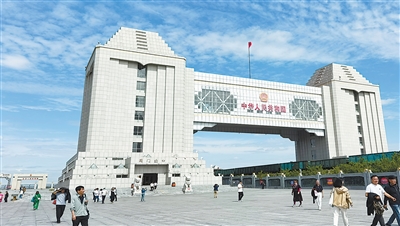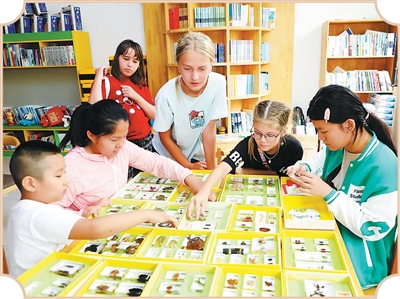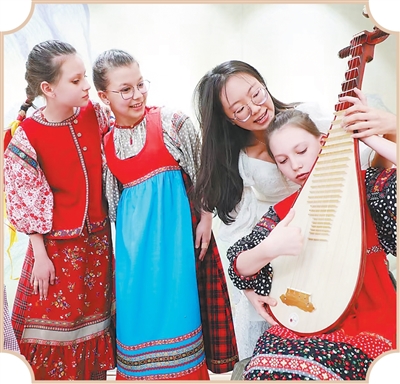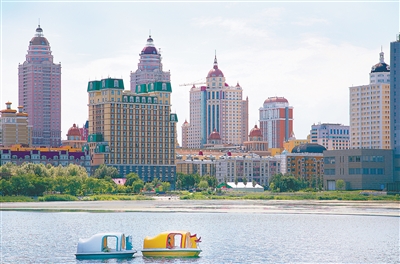
Photo shows the National Gate Resort in Manzhouli, north China's Inner Mongolia Autonomous Region. (Photo/Zhang Peng)
In most places, parents take their kids out to play near home. But in the border city of Manzhouli, north China's Inner Mongolia Autonomous Region, many international tourists cross the border into China to spend time with their children and learn about Chinese culture. Meanwhile, Chinese tourists visit the country's only theme park based on Russian Matryoshka dolls and experience Russian culture and traditions in Manzhouli.
In recent years, leveraging its role as China's largest land port, Manzhouli has hosted a variety of cross-cultural exchange events, attracting a growing number of young people from China, Russia, and Mongolia.

Children from China and Russia observe insect specimens on a study tour in Manzhouli, north China's Inner Mongolia Autonomous Region. (Photo/Wang Huayong)
Every Friday morning, buses from Russia's Far East arrive on schedule at a border checkpoint on the China-Russia border. After disembarking, travelers proceed to the visa hall where they quickly obtain group travel visas and smoothly clear customs to begin their journey in China.
Polina, 9, and Matvei, 10, came to China this way. It's Polina's first time visiting China, and she's especially excited. She shared her wish list: admire Manzhouli's buildings, try roast duck, and sample local desserts. For Matvei, who has visited before, the city's architecture and parks left a lasting impression. This time, in addition to touring Manzhouli, Matvei and his parents will head to Qinhuangdao in north China's Hebei Province to see the sea.

Russian students learn to play the pipa, a pear-shaped stringed instrument in China, in Manzhouli, north China's Inner Mongolia Autonomous Region. (Photo/Wang Huayong)
Like Polina and Matvei, many children from Russia's Far East have visited Manzhouli with their parents in recent years to broaden their horizons. Located at the meeting point of China, Russia, and Mongolia, Manzhouli is not just a trade hub but also a place where the three cultures come together.
Thanks to its rich cultural resources, Manzhouli has become a popular destination for Russian families. Matvei's mother, Irina, said vacationing in Manzhouli is her top choice. She's also planning to take Matvei to explore some of China's science and technology museums.
According to statistics from the Manzhouli port, the port handled over 310,000 inbound tourist trips from Russia in 2024, including more than 56,000 trips made by those under the age of 18.
Next to Manzhouli lies the Zhalainuoer district of Hulun Buir. The Zhalainuoer Museum has become a cultural landmark in Hulun Buir, attracting both domestic and international visitors, many of them from Russia.

Russian tourists shop along a street in Manzhouli, north China's Inner Mongolia Autonomous Region. (Photo/Wang Huayong)
"Starting in early April, people from neighboring countries begin heading out for spring trips. During this time, over half of our daily visitors are from overseas. In 2024 alone, we received nearly 4,500 foreign visitors—most of them from Russia," said Zhang Zhiwen, director of the Zhalainuoer Museum. He admitted he hadn't expected Russian tourists to take such a strong interest in the museum's exhibits on local cultural heritage.
After speaking with museum professionals from Russia's Zabaykalsky Krai, Zhang understood the reason behind the museum's unexpected popularity. The region has a deeply rooted museum-going culture, and residents of its administrative center, Chita, are frequent patrons of museums of all kinds. Now, the rich collections and modern facilities of Hulun Buir's museums offer them exciting new destinations to explore.

A China-Russia student international cultural exchange activity is held in Hulun Buir, north China's Inner Mongolia Autonomous Region. (Photo courtesy of Hulun Buir Cultural Tourism Investment Group Co., Ltd.)
Russian citizens' interest in diverse cultures has also fueled the rise of a broader cross-border tourism trend—study tours—which in recent years have become a popular and influential form of cultural exchange in Manzhouli and across the wider Hulun Buir.
Every March and April, Russian primary and middle school students enjoy a 10-day spring break. During the recent spring break, nearly 5,000 Russian students entered China through Manzhouli to take part in a wide variety of study programs.

Photo shows the Beihu Park in Manzhouli, north China's Inner Mongolia Autonomous Region. (Photo/Dong Heyao)
"In 2024 alone, Hulun Buir Cultural Tourism Investment Group Co., Ltd. organized study tours for over 10,000 Russian students. Our first 'China Friendship Bridge' art competition and study program drew more than 2,000 participants from Russia, setting a record for single-event attendance in cross-border educational travel in Manzhouli," said Tao Guichuan, vice president of the Hulun Buir Culture and Tourism Industry Association.
Source: People's Daily Online








